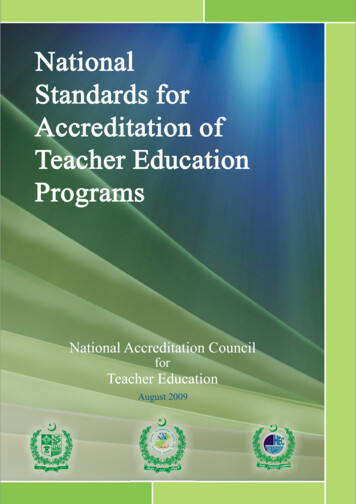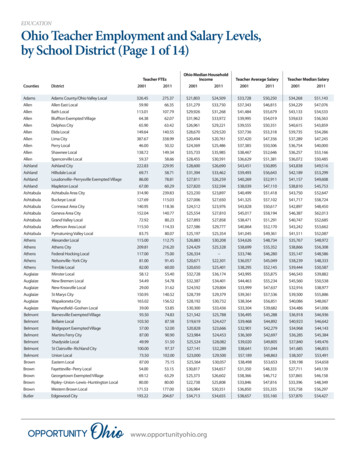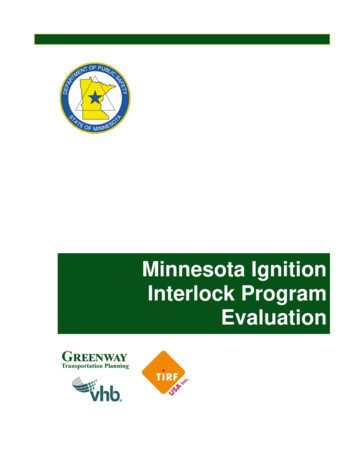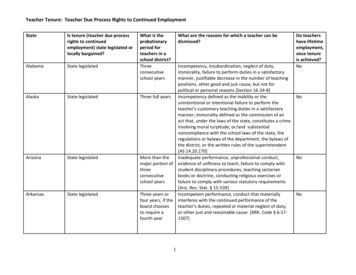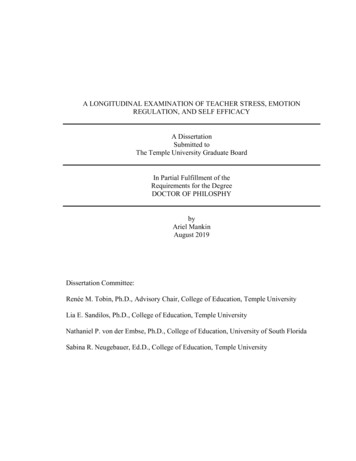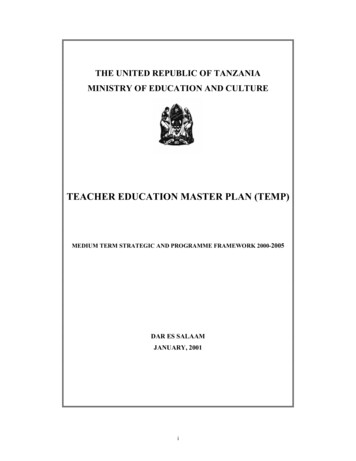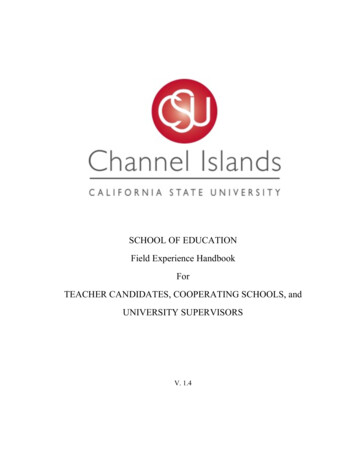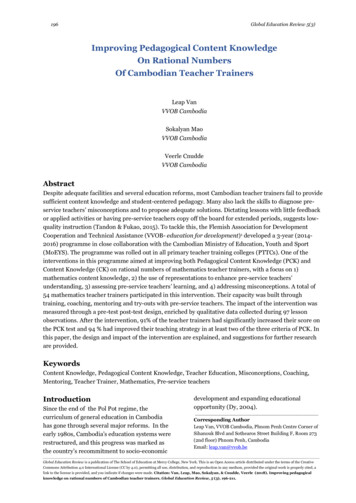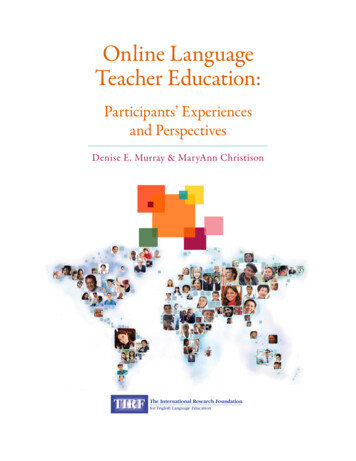
Transcription
Online LanguageTeacher Education:Participants’ Experiencesand PerspectivesDenise E. Murray & MaryAnn ChristisonBOARD OF TRUSTEESJames E. AlatisGeorgetown UniversityWashington, DC USANeil J. AndersonBrigham Young UniversityProvo, UT USAKathleen M. BaileyMonterey Institute of InternationalStudiesMonterey, CA USAChristopher W. BernbrockIBM Global Business PartnersCosta Mesa, CA USAKees de BotUniversity of GroningenGroningen, The NetherlandsDonna ChristianTIRFThe International Research Foundationfor English Language Education
TIRFTIRF – The International Research Foundation for EnglishLanguage Education – promotes research and best practices in theteaching and learning of English. The Foundation supports research onhigh priority topics of current interest through doctoral scholarshipsand commissioned investigations.TIRF is a 501(c)3 nonprofit foundation that was established byTESOL International Association in 1998.Thank you to the provider of graphic design services and compositingfor this publication:Meredith Morgan Digital ArtsSpecializing in graphic design and illustration for the fields ofeducation, architecture, museums and publishing, for online digitaldistribution and for print.This publication has been prepared as an interactive PDF for ease ofuse and more efficient study.Please take advantage of the following tools: Bookmarks of each section and all subsections available inthe vertical panel to the left of the document. Live hyperlinks to websites and documents for furtherreading and research, in the References. Live hyperlink to the TIRF website.Extracts from this document may be reproduced for non-commercial,educational, or training purposes, so long as the original source is cited.Contact us at:Meredith Morgan Design Studioswww.tirfonline.orgwww.meredithmorgan.comor by mail atTIRF177 Webster Street, #220Monterey, CA 93940 USAii310-869-5676iii
ForewordSince the incorporation of TIRF in 1999, the Foundation’s Trusteeshave implemented a research and development program that is generatingnew knowledge, focusing on informing and improving the quality ofEnglish language teaching and learning around the world. The aim ofthese programmatic activities is to promote key investigations by settingresearch priorities, which are intended to promote original research inareas the Trustees consider to be crucial to language education.One of TIRF’s earliest research priorities focused on digitaltechnology and language education. It was established in 2004 andupdated in 2015. In 2010, language teacher education was added as apriority topic for TIRF-funded research. The present study combinesthe Foundation’s foci on digital technology and teacher education. It isthe second TIRF-funded research project about online language teachereducation.In 2013, TIRF published Online Language Teacher Education,by Denise Murray. (Click here to access that study in the form of adownloadable PDF on TIRF’s website.) That project took the first stepin understanding online language teacher education courses through theanalysis of 18 case reports written by individuals in teacher educationprograms and courses.The present study, co-authored by Denise Murray and MaryAnnChristison, takes the next step in investigating the perceptions ofparticipants in OLTE contexts. By surveying both instructors (called“teacher educators” in this report) and enrollees (called “teacherstudents”), Murray and Christison have added substantially to ourunderstanding of OLTE participants’ attitudes towards and perceptionsof providing and taking online courses, in various formats, over differinglengths of study, and via multiple types of technologies.improved to better meet not only the needs of the participants, but alsothe demands of our profession? This paper provides some of the initialinformation the field needs in order to begin to address such questionsabout this important emerging medium for delivering teacher educationinstruction: OLTE.The findings of the present study should be of value to both teacherstudents seeking educational opportunities and teacher educators whoshare their expertise in online contexts. Other stakeholders who willfind this research project informative include program administrators,who may either support employees’ enrollment in OLTE programsor may consider hiring graduates of OLTE courses. It is my hope thattechnology companies will also benefit from the results of this project, asthey play a significant role in developing the software needed to producehigh quality OLTE experiences. I also hope that other researchers willbe motivated to pursue this line of inquiry further, as there are still manyunanswered questions which warrant additional scrutiny.On behalf of the TIRF Board of Trustees, I want to thank Dr. DavidNunan and the administrators of Anaheim University. Their foresightand generosity have enabled TIRF to commission this research project.Kathleen M. Bailey, PhDPresident and Chair, Board of Trustees,The International Research Foundationfor English Language EducationOnline teacher education programs offer flexibility in terms of bothtime and location. People who cannot leave their jobs and/or families toattend training programs at brick-and-mortar institutions are now ableto access educational alternatives through digital technology. What dowe, as a profession, really know about the characteristics of such onlinelanguage teacher education programs? What are their strengths andweaknesses, as viewed by the participants? How can aspects of OLTE beivv
Dr. Maryann ChristisonDr. MaryAnn Christison is a professor in the Department ofLinguistics and the Urban Institute for Teacher Education at theUniversity of Utah in Salt Lake City, Utah, USA. She has a long historyas an English language teacher, teacher educator, and language programadministrator, having been the founding Director of the InternationalCenter and the Teaching Second and Foreign Languages (TSFL)Program at Snow College for 20 years and having worked in both K-12contexts and in adult education. During the summer term and withspecial permission, she also co-teaches OLTE courses with DeniseMurray for Anaheim University’s doctoral program.ProfessorDepartment of Linguistics& The Urban Institutefor Teacher EducationUniversity of Utah,Salt Lake City, Utah, USAviFor seven years, she served on the Board of Directors of TESOLInternational Association, including a term as President in 19971998, and she served as a chair and co-chair for three TESOLconventions—1991 in New York City, 1995 in Long Beach, and2002 in Salt Lake City. In 2012, she received the Alatis Award fromTESOL International Association. In 2016, as part of TESOL’s 50thanniversary, she was recognized with a “TESOL 50@50 Award,” anaward given to 50 TESOLers who have made a significant contributionto the TESOL profession through teaching, research, and leadership.She is on the TIRF Board of Trustees, serving as Chair of the ResearchAdvisory Committee.Dr. Christison’s current research interests includecontent and language integrated learning, languageteacher education, OLTE, teacher cognition,leadership in language education, and language andthe brain. She has published over 100 articles inrefereed journals and chapters in books and is anauthor, co-author, and co-editor of more than 20books. She has trained English language teachers inover 35 countries.Dr. Denise E. MurrayDr. Denise E. Murray is Professor Emeritus at Macquarie Universityin Sydney and at San José State University in California. She has along history as a language teacher educator, having been the ExecutiveDirector of the Adult Migrant English Program Research Centre andof the National Centre for English Language Teaching and Researchat Macquarie University from 2000-2006. Prior to her appointment atMacquarie, she was founding Chair of the Department of Linguisticsand Language Development at San José State University.For seven years, she served on the Board of Directors of TESOLInternational Association, including a term as President in 1996-1997.In 2016, as part of TESOL’s 50th anniversary, she was recognized witha “TESOL 50@50 Award,” an award given to 50 TESOLers who havemade a significant contribution to the TESOL profession throughteaching, research, and leadership. She also received the James E. AlatisService Award from TESOL International and the Sadae Iwataki ServiceAward from CATESOL.Dr. Murray’s own research interests include computer-assistedlanguage learning; cross-cultural literacy; the use of the learners’ L1 inthe second language classroom; the intersection of language, society,and technology; settlement of adult immigrants; OLTE; languageeducation policy; and leadership in language education. She haspublished her work in 17 books and more than 100 articles.ProfessorEmeritusMacquarie Universityin Sydney &San José State Universityin CaliforniaShe has had a lifelong interest in distanceeducation, focused on how to make educationaccessible to those whose physical place, availabletime, and other life circumstances make it impossibleto attend a brick-and-mortar institution.vii
Table of ContentsAcknowledgments 16.1.4.1 Technical Support from Teacher Educators 43List of Acronyms and Abbreviations 26.1.4.2 Technical Support from Technical Support Personnel 47Executive Summary 4481. Context of the Study 106.2.1 Courses vs. Programs 492. Key Research Questions 116.2.2 Time Descriptors for Courses and Programs 503. Methodology: How the Research was Conducted 136.2.3 Accreditation of OLTE Courses and Programs 514. Literature Review 164.1 What is OLTE? 6.2.3.1 Indirect Indicators of Quality 51166.2.4 Types of Support for OLTE Courses and Programs 534.2.1 Sociocultural and Economic Contexts that Affect Access 196.2.5 OLTE Course Workload 534.2.2 Configurations for OLTE Delivery 246.3 Learning Management Systems 544.2.2.1 Synchronous vs. Asynchronous Courses 256.3.1 Commonly Used LMSs 544.2.2.2 Learning Management Systems 276.3.2 Preferences for LMSs 544.2.2.3 Social Media 276.3.3 Features of LMSs 554.2.2.4 Flipped Learning 286.3.4 Participants' Preferences for Features of LMSs 564.2.2.5 Learning Oriented Assessment 296.4 Reasons for Choosing OLTE 584.2.3 Measuring Quality of OLTE 316.5 Configurations of OLTE 634.2.4 The Changing Roles of Teacher Educators and Teacher Students 346.5.1 Experiences with Configurations of OLTE 635. Data Analysis 366.5.2 Perceptions of Delivery Configurations 646. Findings 386.5.3 Reasons for Participants’ Preferences 65386.6 Synchronous vs. Asynchronous Online Learning 666.1 Participants viii6.2 OLTE Courses and Programs 6.1.1 Age and Language Backgrounds 386.6.1 Synchronous Applications 716.1.2 Course Instructors 396.6.2 Features of Synchronous Applications 736.1.3 Experience with Technology 406.6.2.1 Sample Comments from Teacher Educators 746.1.4 Technical Support 436.6.2.2 Sample Comments from Teacher Students 76ix
Acknowledgments6.6.3 Social Media in Totally Online Courses 796.6.3.1 Sample Comments from Teacher Educators and Teacher Students 796.7 Assessments 7. Discussion 80837.1 Research Question 1: Who is participating in OLTE courses and programs? 837.2 Research Question 2: What courses are offered? 857.3 Research Question 3: What types of applications and technologies are usedin the delivery of OLTE courses and programs? 8. Implications 88918.1 Flexibility 928.2 Technical Expertise 928.3 Configuration of Technology 938.4 Quality 949. References 98Appendix A: Teacher Educator Questionnaire 109Appendix B: Teacher Student Questionnaire 149Appendix C: Institutions Contacted 194This project was made possible through contributions from themany different people who offered support, advice, critiques, data,professional information, and interest in the topic of online languageteacher education (OLTE).The most important contributions come from the participants inthe study, who were both instructors of and students in OLTE coursesand programs. They volunteered their valuable time to complete thequestionnaires, and in doing so, they provided detailed informationabout their perceptions of OLTE courses and programs. We are gratefulfor their willingness to participate, for their enthusiasm for OLTE, andfor their deep commitment to the field.TIRF’s Board of Trustees and staff maintained an interest in theresearch throughout the project and continued to offer feedback andsupport. We are especially grateful to Dr. Kathi Bailey, President ofTIRF and Chair of the TIRF Board of Trustees, for her enthusiasmfor the project, her sense of humor, and her dedication to ensuring aquality project. Ryan Damerow, TIRF’s Chief Operating Officer, hasbeen a consummate professional, overseeing the publication and designprocess, and ensuring that the project is of high quality and presents aconsistent image in keeping with TIRF’s commissioned papers.We would especially like to thank TIRF’s donors who made thisproject possible. In particular, we want to thank Dr. David Nunan, theTIRF Trustee who made the initial donation for this phase of TIRF’scommissioned research on OLTE and then spurred the research forwardby securing additional funding from Anaheim University througha challenge grant. We are grateful to both Dr. Nunan and AnaheimUniversity for their commitment to promoting research in the field andfor furthering our understanding of the variables involved in creatingeffective online language teacher education courses and programs.Thank you.Denise E. MurrayMaryAnn Christisonx1
List of Acronymsand AbbreviationsACRONYM2TERMOLTEOnline Language Teacher EducationACCETAccrediting Council of Continuing Education and TrainingOTTSAOnline TEFL & TESOL Standards AgencyACTDECAccreditation Council for TESOLDistance Education CoursesSSTSocial Shaping of TechnologyASQAAustralian Skills Quality AuthorityTATeaching AssistantBYODBring Your own DeviceTEFLTeaching English as a Foreign LanguageCAEPCouncil for the Accreditation of Educator PreparationTESLTeaching English as a Second LanguageCALLComputer-assisted Language LearningTESOLTeachers of English to Speakers of Other Languages/Teaching English to Speakers of Other LanguagesCMSCourse Management SystemTESPTeaching English for Specific PurposesCoPCommunity of PracticeTEYLTeaching English to Young LearnersDEACDistance Education Accrediting CommissionTIRFDLDistance LearningThe International Research Foundationfor English Language EducationedXNon-profit Provider of MOOCsUCLAUniversity of California, Los AngelesEurodlEuropean Journal of Open, Distance and e-LearningUSCUniversity of Southern Californiaf2fFace-to-faceVOIPVoice Over Internet ProtocolWASCWestern Association of Schools and CollegesIATEFLInternational Association of TeachingEnglish as a Foreign LanguageIRRODLInternational Review of Research inOpen and Distance LearningLMSLearning Management SystemLOALearning Oriented AssessmentMOOCMassive Open Online CourseNNSNon-native SpeakerNSNative SpeakerOECDOrganization for Economic Cooperationand DevelopmentOLCOnline Learning ConsortiumOther Conventions Used US spelling and syntax are used, except where quotingdirectly from another source. Different countries use different terms to describevarious qualifications. US conventions are used, exceptwhen naming titles of specific qualifications. Therefore,certificates, diplomas, and degrees taken beyond a firstdegree are referred to as graduate certificates, diplomas,and degrees. Similarly, education beyond secondary level isreferred to generically as post-secondary. Institutions thatare universities or post-secondary degree-granting collegesare referred to as universities/colleges.3
Executive SummaryThe use of computer technology in education has grown, especially sincethe advent of Web 2.0 (i.e., the collection of second-generation internetservices that were built on the expansion of social media technologies), withits affordances for teaching and learning. Increasingly, technology-enhancededucation is being delivered online, rather than in stand-alone computer labs.The online delivery of education ranges from some online support for face-toface (f 2f ) classes, to totally online courses including online language teachereducation (OLTE). The need for OLTE has increased with the demand forEnglish teaching and for qualified instructors as English use as a global languagehas increased.The study reported here built on that of Murray (2013). Murray’s studyprovided an overview of the types of OLTE available and included in-depthsnapshots of 18 OLTE courses/programs. The Murray 2013 study laid thegroundwork for understanding more about OLTE courses and programs,in other words, what is being offered and by whom. Since the publication ofMurray’s 2013 study, we have had numerous conversations about OLTE withinstructors and students in courses and administrators in and directors ofOLTE programs, as well as other researchers. What has become increasinglyapparent to us as a result of these discussions is that we need to learn more aboutthe experiences and perceptions of the individuals involved in OLTE. What arethe characteristics of OLTE participants? Why do participants choose online,rather than on-campus or f2f courses and programs? What types of technologyand course configurations have they experienced and which do they prefer?What are participants’ perceptions of online learning and the applicationsavailable for learning? Understanding what OLTE participants think, know,and believe about OLTE can be enormously useful in creating more effectiveonline learning environments, designing courses and programs, and assuringquality of OLTE. Therefore, the focus of the current study reported here is theexperiences and the perceptions of both instructors of and students in OLTEcourses and programs.4To carry out the study, we developed two online questionnaires, one forinstructors of OLTE (i.e., teacher educators) and the other for students in OLTE(i.e., teacher students). The items in the questionnaire were developed based oncurrent literature on online education and our own experiences in OLTE inseveral different settings and programs. The questionnaires included multiplechoice, rank-order, and short-answer questions, often with an option for writein responses. The questionnaires sought to discover who is participating inOLTE courses/programs and why; the types of OLTE courses and programsavailable; the configurations of these courses/programs, including activities andtechnologies; participants’ preferences for OLTE activities and technologies;and participants’ perceptions of the effectiveness of OLTE courses and theapplications for the delivery of the course. We classified OLTE into fiveconfigurations: (1) enhanced, (2) blended/hybrid, (3) flipped, (4) totally onlinewith a synchronous component, and (5) totally online with no synchronouscomponent. The term configuration is being used specifically to talk about howonline technologies are being implemented in the design of courses.One hundred eighty-five (185) programs/courses were contacteddirectly via email and invited to participate. They were asked to distributethe call for participation to their teacher educators and teacher students. Inaddition, the call for participation with the URL link to the questionnaireswas posted on several TESOL professional websites and listservs. A total of137 teacher educator questionnaires were returned and 309 teacher studentquestionnaires for a total of 446 responses. The quantitative data wereanalyzed using Qualtrics, while the qualitative data were searched for themesand then coded to create categories that were related to the main constructsrepresented in the questions.5
FindingsWhile there was some agreement between teacher educators and teacherstudents, their experiences and opinions differ considerably on many key factors.ParticipantsBoth native speakers (NS) and non-native speakers (NNS) of Englishparticipated in the OLTE surveys. It is important to note that the terms NSand NNS are used in this report only as useful heuristics. Participants werelocated in many different contexts around the world, including Asia, Australia,Europe, the Middle East, North America, and South America. Teacher educatorswere a considerably older cohort (the largest group was in their 50s) thantheir teacher students (the largest group was in their 20s). Perceptions ofworkload for OLTE courses varied a great deal between teacher students andteacher educators. Teacher educators indicated that the workload is muchheavier in online courses than in f2f courses, while teacher students perceivedthe workload as being similar to f2f courses.Reasons for Choosing OLTEData were collected about general reasons for choosing OLTE courses andreasons for choosing OLTE over f 2f courses. Teacher students reported that theychose to study OLTE in general and to obtain credentials in English languageteaching, whereas the teacher educators’ perception was that their teacherstudents mainly wanted to travel or took courses required by their employers.The reasons for choosing OLTE over f 2f for teacher students were relatedto flexibility; consequently, teacher students did not welcome synchronouslectures or discussion groups. They wanted to take full advantage of the anytime, any-place affordance of online learning. In contrast, teacher educatorswanted to encourage interaction and facilitation of group work. To this end,they used a variety of different technologies to promote both synchronousand asynchronous participation. The teacher educators did perceive that theirteacher students took online courses for their flexibility, but they includedlearning activities that made their courses less flexible.6Configurations of OLTEBoth teacher educators and teacher students had the most experience withasynchronous online OLTE courses, followed by blended/hybrid for teacherstudents and enhanced for teacher educators. Teacher educators did, however,use a variety of synchronous applications. In terms of preferences, teachereducators ranked a totally online course with no synchronous component thelowest, whereas teacher students ranked it as their highest preference. Thesepreferences reflected the differing beliefs that teacher educators and teacherstudents had about the value of OLTE—teacher educators preferred modes andconfigurations that allowed for interaction, whereas teacher students preferredmodes that gave them the greatest flexibility. They both ranked enhancedcourses quite high, but flipped courses quite low. The participants also taughtin or learned in a range of courses and programs, from short courses measuredby hours to multi-year-long degree programs.QualityNeither teacher educators nor teacher students were particularly interestedin or often aware of accreditation as a measure of quality. Indirect measures ofquality indicated that neither teacher educators nor teacher students believedOLTE was easier than f 2f study. Flexibility reflected quality for teacherstudents, whereas the availability of applications for promoting interactionsuggested quality for teacher educators. Teacher educators in this study wereexperienced as teacher educators and considered themselves qualified to teachOLTE and support their students’ learning because most had taught and/ordesigned OLTE, had undertaken formal technical training, and had obtainedexperience as teacher educators. Teacher students reported that their teachereducators were experienced and qualified. Most were instructors, only a fewbeing tutors or teaching assistants.Technical SupportTeacher educators, even those with considerable experience and/or trainingwith OLTE, did not have high levels of confidence in their technologicalcompetence. In contrast, teacher students were confident. Teacher educators7
did, however, provide some technical support to their teacher students, andteacher students’ perceptions of the technical support provided by teachereducators were more positive than the perceptions that the teacher educators hadof themselves. In addition, a number of OLTE programs had technical supportstaff persons who were available to answer questions about the technology.Learning Management System (LMS)The most commonly used LMSs for teacher educators were Blackboard,followed by Moodle, Canvas, WebCT, and locally designed LMSs. Teacherstudents most frequently used Moodle, followed by Blackboard, WebCT,locally designed LMSs, and Canvas. Teacher educators preferred WebCTwhile teacher students preferred locally designed learning LMSs. However,teacher educators ranked “other” LMSs and applications as second in theiroverall list of preferences and teacher students ranked “other” as first in theirlist of preferences. Both provided extensive lists of other LMSs and programs.Although the preferences for specific features expressed by the two groupswere similar (e.g., flexibility, transparency, messaging system, and synchronousapplications), there were some differences. Teacher educators placed a highpriority on features that promote interaction, group work, and communication.In contrast, teacher students placed a high priority on features that assist themin doing well in the courses, such as features that allowed them to track theirown progress and have access to grades.AssessmentsExams still figured quite prominently as a form of assessment, even thoughteacher educators and teacher students agreed that online quizzes that allowedfor multiple attempts and provided immediate feedback, peer assessments,and practice quizzes that included answers and explanations were all useful inpromoting learning.ImplicationsThese findings produced a rich understanding of the world of OLTE.For OLTE to meet its full potential of providing quality education for thosewho choose not to attend brick-and-mortar institutions requires institutionsto rethink why they are providing OLTE and what configurations they have8chosen to adopt. Institutions and teacher educators embarking on OLTE,therefore, need to consider the following: balance the needs and wants of their teacher students with their ownpedagogical beliefs and practices; determine who should provide technical support for teacher students– teacher educators or technical staff – and make this decisionunderstood by all participants; carefully evaluate new technologies to determine their fit-for-purposefor both teacher educators and teacher students; provide clear information for prospective teacher students so they canmake informed decisions about what programs meet their needs andpreferences, including technologies used, pedagogical approaches, andtypes of assessments; evaluate their compensation for teacher educators by examiningadditional workload in terms of time and in terms of role, such astechnical expert; and constantly evaluate the quality of their OLTE programs or courses,using tools such as accreditation or the Online Learning Consortium’sscorecard.Potential teacher students need to carefully examine not only the availabilityof OLTE, but also the exact configurations used in the program or course, thequalifications and expertise of the teacher educators, the administrative andtechnical support provided, and the underlying curriculum design. Professionalassociations in TESOL should consider advocating for quality accreditationprinciples for OLTE. Other stakeholders, such as software companies, shouldalso examine the findings so that their products more effectively match theneeds of OLTE teacher educators and teacher students.Additional research is needed to fill the gap in our understanding of the impact of OLTE on hiringpractices of graduates and the perceptions of how well prepared OLTEgraduates are for their language teaching work, and examine the compensation for OLTE teacher educators.9
1. Context of the StudyThe use of computers in education has grown exponentially over thepast several decades, including in language teaching (computer-assistedlanguage learning—CALL). (See, for example Healey, Hanson-Smith,Hubbard, Ioannou-Georgiou, Kessler, & Ware, 2011; OECD, January,2008; Reinders & White, 2011; The Sloan Consortium, 2005; Thomas,Reinders, & Warschauer, 2013.) This growth can also be seen in generalteacher education (Collis & Jung, 2003; Robinson & Latchem, 2003)and language teacher education (England, 2012; Hall & Knox, 2009;Hubbard, 2008; Murray, 2013). The recent growth has come from Web2.0, the collection of second-generation internet services that were builton the expansion of social media technologies. These technologies haveresulted in connectivism (Siemens, 2005), which is a theory of learningthat is based on the notion that internet technologies have created uniqueopportunities for individuals to learn from one another. Connectivismallows individuals to share information in an environment in which thecore elements are constantly shifting and evolving and are not entirelyunder the control of the individual.In 2001, Warschauer (2001) characterized the historical developmentof CALL as falling into three stages as follows: Structural (1970s-80s) Communicative (1980s-90s) 21st-century integrativeHe stated that 21 -century integrative CALL is driven bymultimedia and the internet, which have allowed for content-basedlanguage teaching, the use of authentic discourse, and learner agency.However, since his portrayal of CALL in the 21st century, social mediahave blossomed and handheld devices have become common, resultingin new opportunities and affordances for teachers and learners. Theseaffordances have included collaboration, communities of practice (CoP;Wenger, 1998), and a focus on social media.st102. Key Research QuestionsThe study reported here builds on Murray’s 2013 study, whichexamined online language teacher education (OLTE) through (1) aliterature review, (2) desktop evaluation of websites of OLTE providersglobally, and (3) 18 case reports of programs from a va
IBM Global Business Partners Costa Mesa, CA USA Kees de Bot University of Groningen Groningen, The Netherlands Donna Christian Center for Applied Linguistics Washington, DC . Program at Snow College for 20 years and having worked in both K-12 contexts and in adult education. During the summer term and with
